Research on Compliance Thresholds Based on Analysis of Driver Behavior Characteristics
Abstract
1. Introduction
2. Materials and Methods
2.1. Natural Driving Dataset
2.2. Natural Driving Data Filtering
3. Results and Discussion
3.1. Analysis of Preceding Vehicle Behavior
3.2. Analysis of Following Vehicle Behavior
4. Conclusions
Author Contributions
Funding
Data Availability Statement
Acknowledgments
Conflicts of Interest
References
- WHO. Global Status Report on Road Safety 2023; WHO: Geneva, Switzerland, 2023. [Google Scholar]
- Wang, X.; Meng, L.-M.; Zhang, B.; Lu, J.; Du, K.-L. A Video-Based Traffic Violation Detection System. In Proceedings of the 2013 International Conference on Mechatronic Sciences, Electric Engineering and Computer (MEC), Shengyang, China, 20–22 December 2013; pp. 1191–1194. [Google Scholar]
- Şentaş, A.; Kul, S.; Sayar, A. Real-Time Traffic Rules Infringing Determination Over the Video Stream: Wrong Way and Clearway Violation Detection. In Proceedings of the 2019 International Artificial Intelligence and Data Processing Symposium (IDAP), Malatya, Turkey, 21–22 September 2019; pp. 1–4. [Google Scholar]
- Zubair, S.; Rothman, L.; Kuimi, B.B.; Macpherson, A.; Cloutier, M.-S.; Howard, A. 129 Effectiveness of Automated Speed Enforcement in Reducing Vehicle Speeds within School Community Safety Zones in Toronto, Canada. Inj. Prev. 2024, 30, A21. [Google Scholar] [CrossRef]
- Beijing Intelligent Vehicle Association Industry Innovation Center Road Test Report of Self-Driving Vehicles in Beijing. 2023. Available online: http://www.mzone.site/index.php/index/index/cid/2/sid/21.html (accessed on 30 October 2024).
- Shanghai Municipal Transportation Commission Report on the Development of Intelligent Connected Vehicles in Shanghai. 2023. Available online: https://jtw.sh.gov.cn/zxzfxx/20240205/7aa0c16cc00e42cb9b3311b564dc8ffe.html (accessed on 30 October 2024).
- Buechel, M.; Hinz, G.; Ruehl, F.; Schroth, H.; Gyoeri, C.; Knoll, A. Ontology-Based Traffic Scene Modeling, Traffic Regulations Dependent Situational Awareness and Decision-Making for Automated Vehicles. In Proceedings of the 2017 IEEE Intelligent Vehicles Symposium (IV), Los Angeles, CA, USA, 11–14 June 2017; pp. 1471–1476. [Google Scholar]
- Rizaldi, A.; Immler, F.; Althoff, M. A Formally Verified Checker of the Safe Distance Traffic Rules for Autonomous Vehicles. In Proceedings of the NASA Formal Methods; Rayadurgam, S., Tkachuk, O., Eds.; Springer International Publishing: Cham, Switzerland, 2016; pp. 175–190. [Google Scholar]
- Maierhofer, S.; Moosbrugger, P.; Althoff, M. Formalization of Intersection Traffic Rules in Temporal Logic. In Proceedings of the 2022 IEEE Intelligent Vehicles Symposium (IV), Aachen, Germany, 4–9 June 2022; pp. 1135–1144. [Google Scholar]
- Krasowski, H.; Althoff, M. Temporal Logic Formalization of Marine Traffic Rules. In Proceedings of the 2021 IEEE Intelligent Vehicles Symposium (IV), Nagoya, Japan, 11–17 July 2021; pp. 186–192. [Google Scholar]
- Wan, L.; Wang, C.; Luo, D.; Liu, H.; Ma, S.; Hu, W. Semantic Consistency and Correctness Verification of Digital Traffic Rules. Engineering 2024, 33, 47–62. [Google Scholar] [CrossRef]
- Xu, L.; He, B.; Zhou, H.; He, J. Impact and Revolution on Law on Road Traffic Safety by Autonomous Driving Technology in China. Comput. Law Secur. Rev. 2023, 51, 105906. [Google Scholar] [CrossRef]
- Tengilimoglu, O.; Carsten, O.; Wadud, Z. Are Current Roads Ready for Highly Automated Driving? A Conceptual Model for Road Readiness for AVs Applied to the UK City of Leeds. Transp. Res. Part A Policy Pract. 2024, 186, 104148. [Google Scholar] [CrossRef]
- Wang, X.; Zhu, M.; Chen, M.; Tremont, P. Drivers’ Rear End Collision Avoidance Behaviors under Different Levels of Situational Urgency. Transp. Res. Part C Emerg. Technol. 2016, 71, 419–433. [Google Scholar] [CrossRef]
- Yang, H.; Zhao, X.; Luan, S.; Chai, S. A Traffic Dynamic Operation Risk Assessment Method Using Driving Behaviors and Traffic Flow Data: An Empirical Analysis. Expert Syst. Appl. 2024, 249, 123619. [Google Scholar] [CrossRef]
- Li, L.; He, J.; Liu, W. Threat Assessment Algorithm Based on Characteristics of Driver Emergency Braking Behavior. J. Tongji Univ. (Nat. Sci.) 2014, 42, 109–114. [Google Scholar]
- Pek, C.; Zahn, P.; Althoff, M. Verifying the Safety of Lane Change Maneuvers of Self-Driving Vehicles Based on Formalized Traffic Rules. In Proceedings of the 2017 IEEE Intelligent Vehicles Symposium (IV), Los Angeles, CA, USA, 11–14 June 2017; pp. 1477–1483. [Google Scholar]
- Shalev-Shwartz, S.; Shammah, S.; Shashua, A. On a Formal Model of Safe and Scalable Self-Driving Cars. arXiv 2018, arXiv:1708.06374. [Google Scholar]
- Su, S.; Ge, Y.; Hou, P.; Wang, X.; Wang, Y.; Lyu, T.; Luo, W.; Lai, Y.; Ge, Y.; Lyu, L. China VI Heavy-Duty Moving Average Window (MAW) Method: Quantitative Analysis of the Problem, Causes, and Impacts Based on the Real Driving Data. Energy 2021, 225, 120295. [Google Scholar] [CrossRef]
- Bhavsar, Y.M.; Zaveri, M.S.; Raval, M.S.; Zaveri, S.B. Vision-Based Investigation of Road Traffic and Violations at Urban Roundabout in India Using UAV Video: A Case Study. Transp. Eng. 2023, 14, 100207. [Google Scholar] [CrossRef]
- Chen, Q.; Huang, H.; Li, Y.; Lee, J.; Long, K.; Gu, R.; Zhai, X. Modeling Accident Risks in Different Lane-Changing Behavioral Patterns. Anal. Methods Accid. Res. 2021, 30, 100159. [Google Scholar] [CrossRef]
- Wang, X.; Liu, Q.; Guo, F.; Fang, S.; Xu, X.; Chen, X. Causation Analysis of Crashes and near Crashes Using Naturalistic Driving Data. Accid. Anal. Prev. 2022, 177, 106821. [Google Scholar] [CrossRef] [PubMed]
- Esenturk, E.; Turley, D.; Wallace, A.; Khastgir, S.; Jennings, P. A Data Mining Approach for Traffic Accidents, Pattern Extraction and Test Scenario Generation for Autonomous Vehicles. Int. J. Transp. Sci. Technol. 2023, 12, 955–972. [Google Scholar] [CrossRef]
- Kovaceva, J.; Isaksson-Hellman, I.; Murgovski, N. Identification of Aggressive Driving from Naturalistic Data in Car-Following Situations. J. Saf. Res. 2020, 73, 225–234. [Google Scholar] [CrossRef]
- Lee, J.; Jang, K. Characterizing Driver Behavior Using Naturalistic Driving Data. Accid. Anal. Prev. 2024, 208, 107779. [Google Scholar] [CrossRef]
- Li, H.; Li, Y.; Chen, K.; Zhao, X. Driving Behavior of L3 Autonomous Vehicle Drivers in Fog Zones under Different Traffic Flow Conditions. Measurement 2023, 207, 112300. [Google Scholar] [CrossRef]
- Li, G.; Lai, W.; Sui, X.; Li, X.; Qu, X.; Zhang, T.; Li, Y. Influence of Traffic Congestion on Driver Behavior in Post-Congestion Driving. Accid. Anal. Prev. 2020, 141, 105508. [Google Scholar] [CrossRef]
- Zhao, S.; Qi, G.; Li, P.; Guan, W. The Aggressive Driving Performance Caused by Congestion Based on Behavior and EEG Analysis. J. Saf. Res. 2024, 91, 381–392. [Google Scholar] [CrossRef]
- Zhang, Y.; Wang, C.; Yu, R.; Wang, L.; Quan, W.; Gao, Y.; Li, P. The AD4CHE Dataset and Its Application in Typical Congestion Scenarios of Traffic Jam Pilot Systems. IEEE Trans. Intell. Veh. 2023, 8, 3312–3323. [Google Scholar] [CrossRef]
- (GRVA) Proposal for the 01 Series of Amendments to UN Regulation No. 157 (Automated Lane Keeping Systems) | UNECE. Available online: https://unece.org/transport/documents/2022/04/working-documents/grva-proposal-01-series-amendments-un-regulation-no (accessed on 3 December 2024).
- Alonso, B.; Musolino, G.; Rindone, C.; Vitetta, A. Estimation of a Fundamental Diagram with Heterogeneous Data Sources: Experimentation in the City of Santander. ISPRS Int. J. Geo-Inf. 2023, 12, 418. [Google Scholar] [CrossRef]
- Alonso, B.; Pòrtilla, Á.I.; Musolino, G.; Rindone, C.; Vitetta, A. Network Fundamental Diagram (NFD) and Traffic Signal Control: First Empirical Evidences from the City of Santander. Transp. Res. Procedia 2017, 27, 27–34. [Google Scholar] [CrossRef]

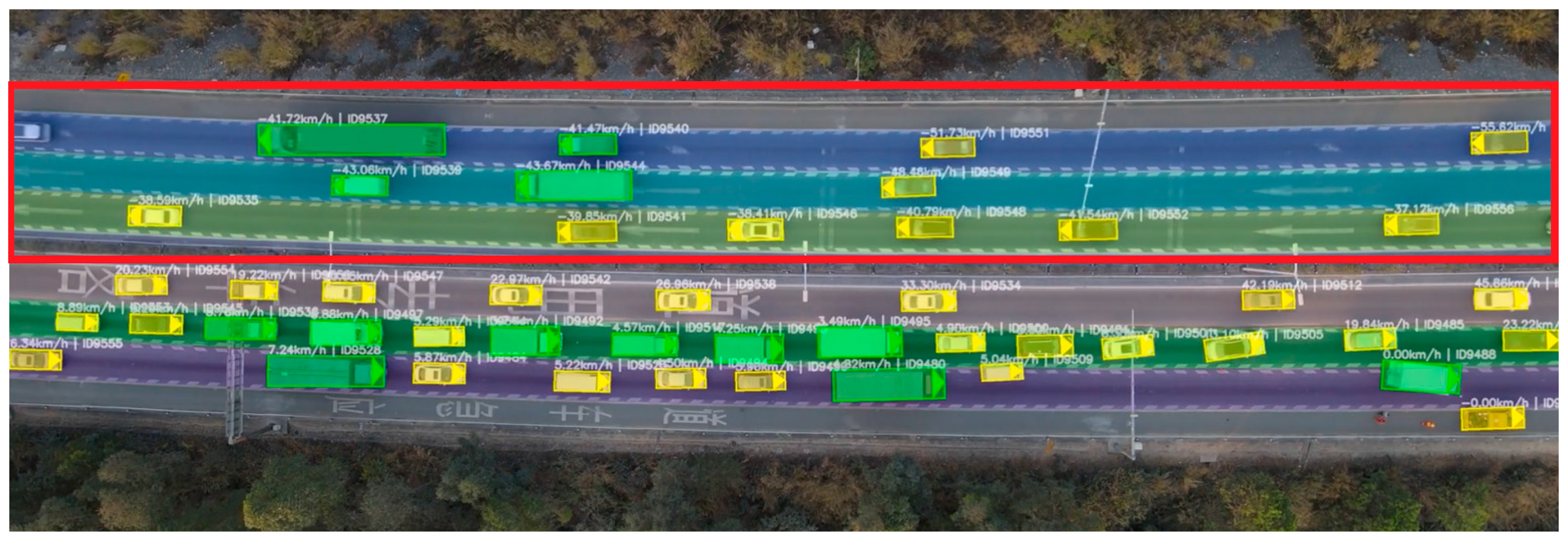
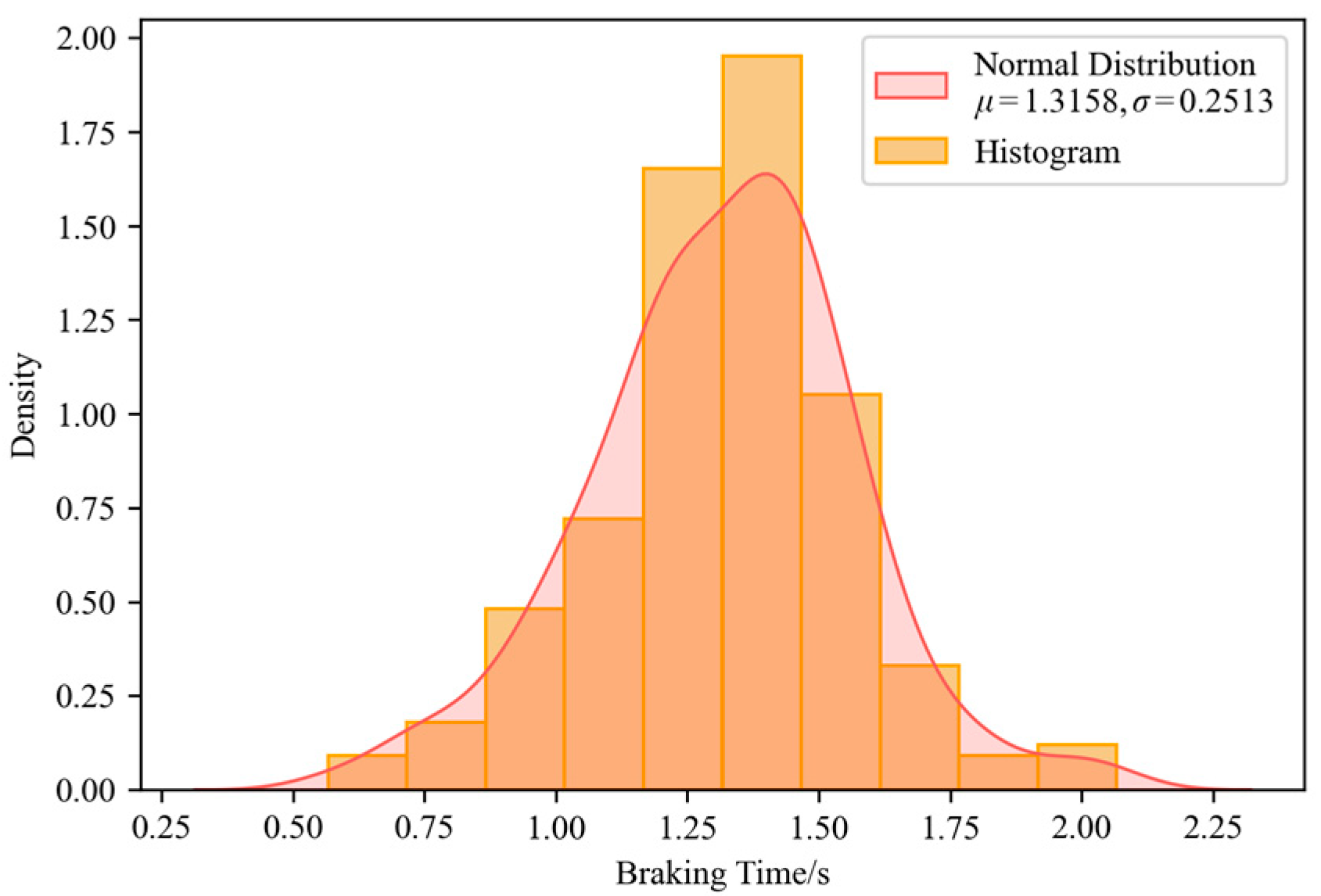

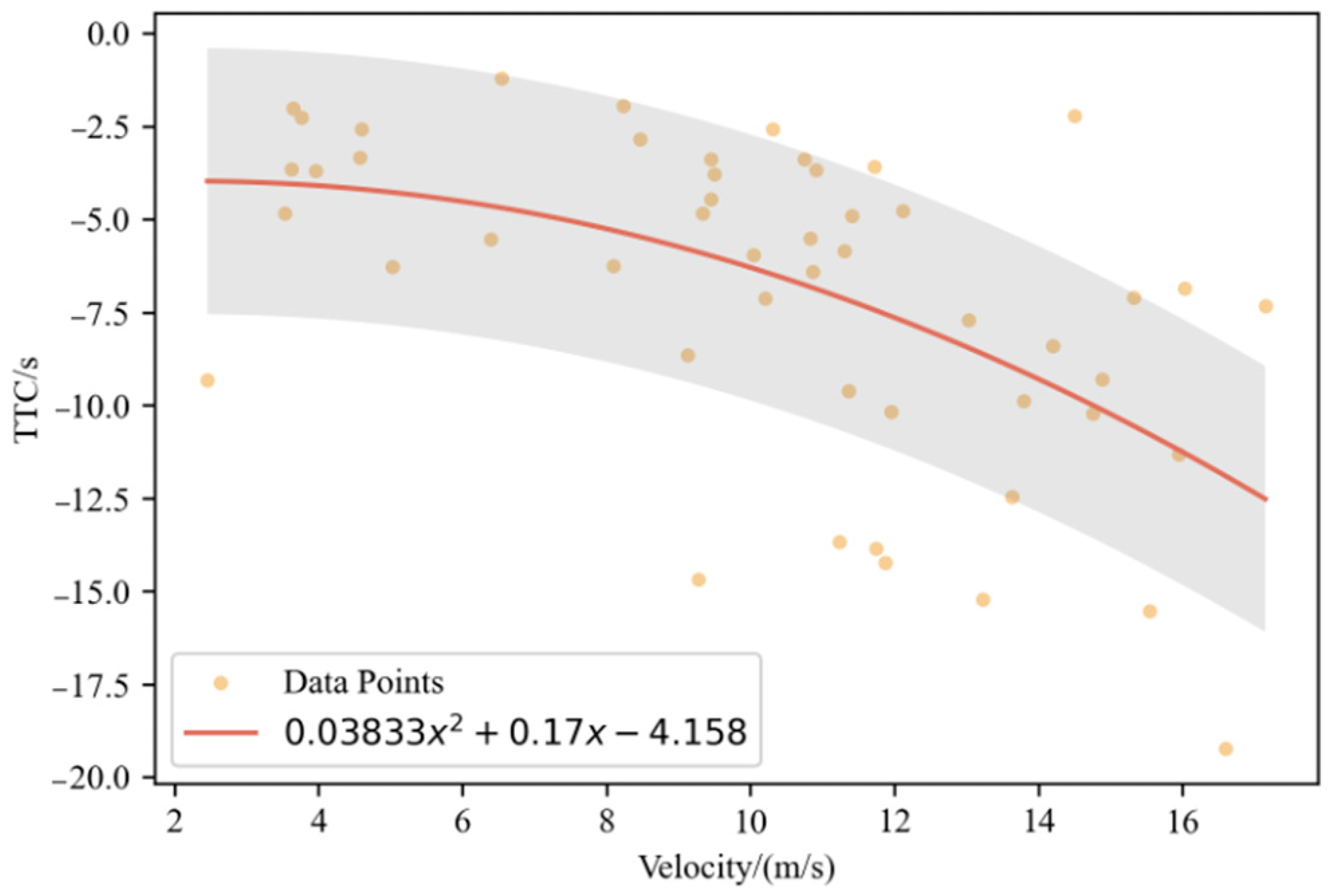
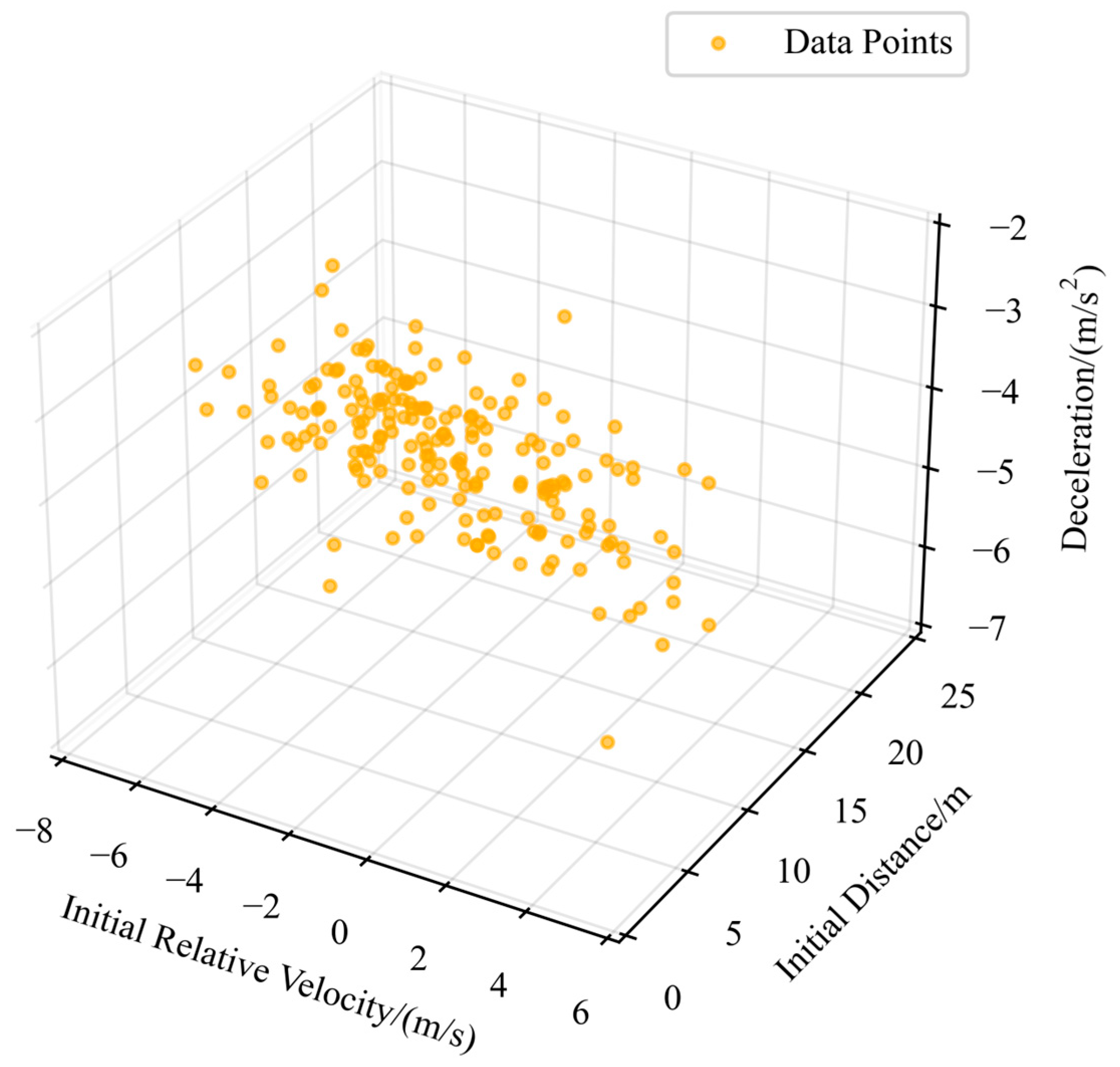

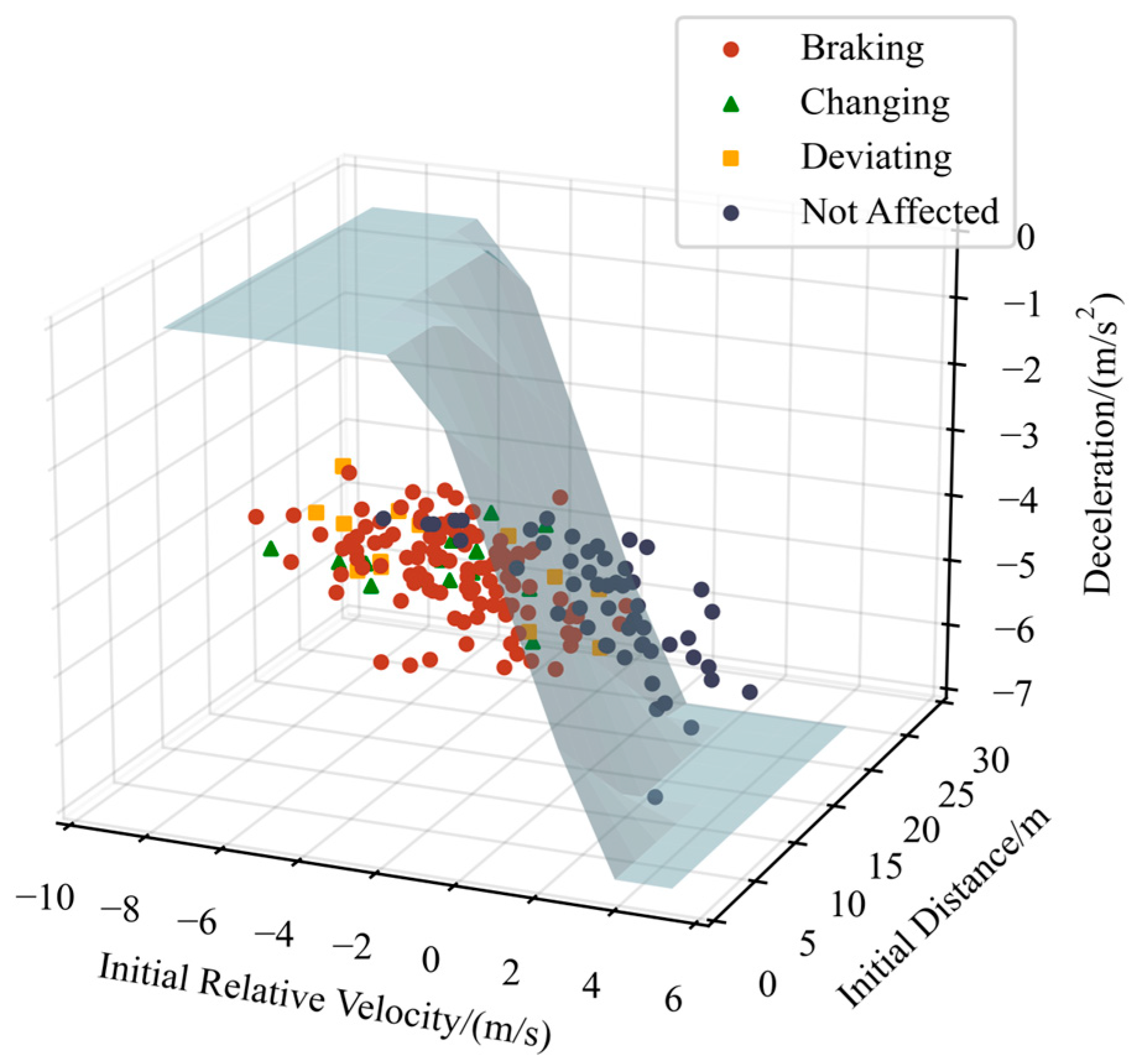
| Preceding Vehicle Behavior | Decrease in Speed | Lane Change |
|---|---|---|
| Count | 2945 | 266 |
| Percentage | 91.72% | 8.28% |
| Preceding Vehicle Behavior | Braking | Lane Change | Deviating from Lane Center | |
| Count | 107 | 34 | 21 | |
| Preceding Vehicle Behavior | Braking with Lane Change | Braking with Deviating from Lane Center | ||
| Count | 17 | 8 | ||
Disclaimer/Publisher’s Note: The statements, opinions and data contained in all publications are solely those of the individual author(s) and contributor(s) and not of MDPI and/or the editor(s). MDPI and/or the editor(s) disclaim responsibility for any injury to people or property resulting from any ideas, methods, instructions or products referred to in the content. |
© 2024 by the authors. Licensee MDPI, Basel, Switzerland. This article is an open access article distributed under the terms and conditions of the Creative Commons Attribution (CC BY) license (https://creativecommons.org/licenses/by/4.0/).
Share and Cite
Ma, M.; Wang, W.; Miao, Z.; Wang, T.; Zhao, G. Research on Compliance Thresholds Based on Analysis of Driver Behavior Characteristics. Systems 2024, 12, 568. https://doi.org/10.3390/systems12120568
Ma M, Wang W, Miao Z, Wang T, Zhao G. Research on Compliance Thresholds Based on Analysis of Driver Behavior Characteristics. Systems. 2024; 12(12):568. https://doi.org/10.3390/systems12120568
Chicago/Turabian StyleMa, Mingyue, Weiqing Wang, Zelin Miao, Tao Wang, and Guangming Zhao. 2024. "Research on Compliance Thresholds Based on Analysis of Driver Behavior Characteristics" Systems 12, no. 12: 568. https://doi.org/10.3390/systems12120568
APA StyleMa, M., Wang, W., Miao, Z., Wang, T., & Zhao, G. (2024). Research on Compliance Thresholds Based on Analysis of Driver Behavior Characteristics. Systems, 12(12), 568. https://doi.org/10.3390/systems12120568







